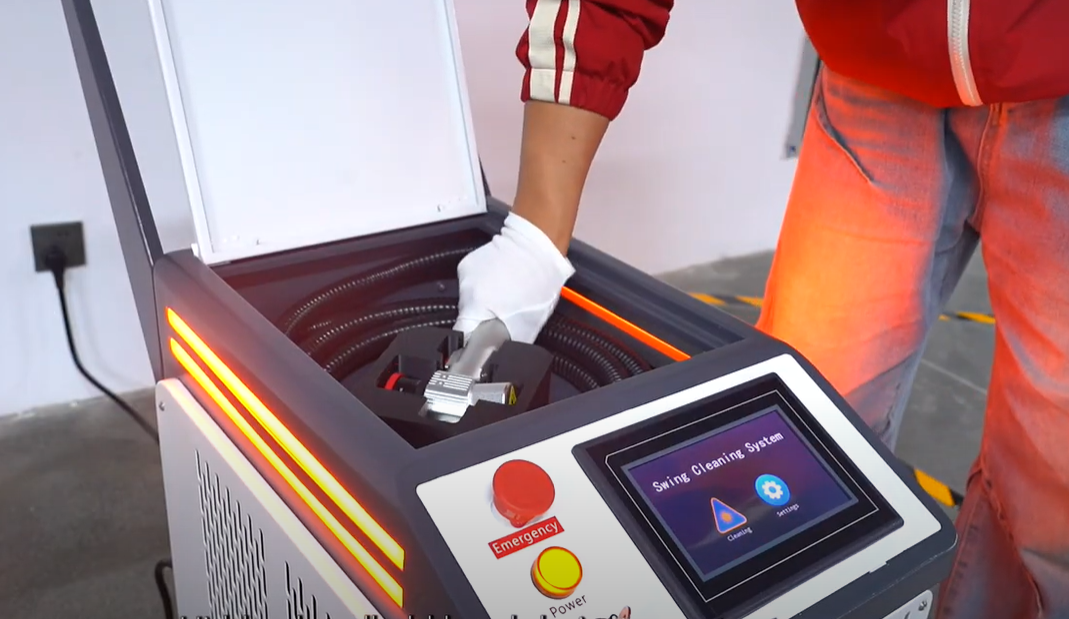レーザーマーキング機械は、焦点を絞った光のビームを使用して表面に永久的にマーキングするための高度な装置です。これらの機械は、レーザー光源、マーキングヘッド、専門のソフトウェアなど、いくつかの重要なコンポーネントで構成されています。レーザー光源は光ビームを生成し、それがマーキングヘッドのレンズを通じて指向され、精密な制御を可能にします。インクジェット印刷やドットピンマーキングなどの従来のマーキング方法とは異なり、レーザーマーキングはその精度、速度、消耗品なしでさまざまな材料にマーキングできる能力で知られています。
レーザーマーキングのプロセスは、レーザービームのエネルギーを使用して、材料の表面を変化させることによってマークを作成することを含みます。このプロセスの背後にある科学は、LASERという頭字語にあります—光の増幅は刺激された放射の放出によるものです。レーザービームが表面に接触すると、その強力なエネルギーは熱として効率的に転送され、黒、白、または他の色のマークを作成することができます。レーザービームの高エネルギーと精度は、金属、ポリマー、ゴムなどの材料にマークを付けるのに適しています。このプロセス全体は非接触であり、インクや化学添加物を使用しないため、環境に優しいです。
レーザーマーキング機は卓越した精度を提供し、製品のブランディングに不可欠な複雑で詳細なデザインの作成を可能にします。この高い精度は、ロゴやバーコードなどのすべてのマークが明確で一貫していることを保証し、ブランドの整合性を維持します。高い精度は、製品の認識を向上させ、消費者にアピールするプロフェッショナルな仕上がりにつながります。たとえば、自動車や電子機器の分野の企業は、レーザーマーキングを利用して製品を独自にブランディングし、競合他社との容易な差別化を図っています。
さらに、レーザーマーキングは非常に耐久性があり、従来の方法よりも長寿命と環境要因への耐性においてしばしば優れています。レーザーマークの永久的な性質は、再マーキングの必要性を減少させ、廃棄物や消耗品の使用を減らすことで持続可能性の目標にうまく合致します。航空宇宙や医療機器製造などの産業は、この耐久性から大いに恩恵を受けており、製品は厳しい条件下でも長期間にわたってトレーサビリティとコンプライアンスを必要とします。
もう一つの利点は、技術の多様性であり、金属、プラスチック、セラミックなどの幅広い材料にマーキングできる能力です。この柔軟性により、精度と材料の多様性が重要なジュエリーのような業界は、基材を損なうことなく製品を装飾するためにレーザーマーキングを使用できます。たとえば、さまざまな材料で作られた自動車部品は、識別と追跡のためにマーキングされ、異なる分野におけるレーザー技術の適応性と広範な応用範囲を示しています。
レーザーマーキングの高度な技術を理解するには、レーザー彫刻とレーザーエッチングの違いを区別する必要があります。レーザー彫刻は、深く永続的なマークを作成するために材料を除去することを含み、金属や重作業用アプリケーションに最適です。この技術は耐久性があり、航空宇宙や自動車などの産業で重要な永続的なマークを提供します。一方、レーザーエッチングは、表面層のみを変更して高コントラストのマークを作成する、やや穏やかなアプローチを使用します。彫刻よりも速く、金属やプラスチックのロゴやシリアル番号に特に適しており、表面の完全性を維持する必要があります。
レーザーマーキング技術は、特定のニーズに合わせたさまざまな方法を含んでいます。その中には、ファイバー、CO2、UVマーキング技術があります。 ファイバーレーザーマーク 金属や特定のプラスチックに特に効果的で、高コントラストで詳細なマークを精密に提供します。効率と精度のため、自動車および電子産業で広く使用されています。 CO2レーザー marking 木材や革などの有機材料のマーキングに多用途であり、看板から包装に至るまでさまざまな産業で人気があります。最後に、 UVマーキング 敏感な材料に対応し、電子機器や医療機器に対して余分な熱を発生させることなく、精密でクリーンなマークを提供します。この方法の多様性により、レーザーマーキングはさまざまな分野での頼りにされるソリューションとなっています。
レーザーマーキング技術は、自動車および航空宇宙産業において不可欠なものとなっています。これらの分野では、部品の識別、トレーサビリティの確保、厳しい業界基準の遵守のためにレーザーマーキングが使用されています。たとえば、自動車産業では、エンジン部品、VIN番号、電気モジュールなどの部品がマーキングされ、サプライチェーン全体でのトレーサビリティが確保されています。同様に、厳しい条件に耐えなければならない航空宇宙部品も、可読性と安全規制の遵守を維持するためにレーザーマーキングを利用しています。正確で耐久性のあるマーキングを提供することにより、レーザーマーキングはこれらの産業における説明責任と効率を向上させます。
医療機器および電子機器の製造業者は、規制遵守と製品の差別化を確保するためにレーザーマーキング技術に大きく依存しています。医療機器製造業者は、製品にユニークデバイス識別(UDI)コードを実装する必要があり、これはレーザーマーキングによって簡単に満たされる要件です。これにより、重要な医療機器が運用上および安全上の理由から正確に識別できるようになります。同様に、電子産業では、回路基板や部品に独自の識別子を刻印するためにレーザーマーキングを使用し、リコール時の簡単な追跡や市場での製品の真正性を確保しています。したがって、レーザーマーキングは、これらの分野における信頼性の維持と公衆の健康と安全の保護において重要な役割を果たしています。
適切なレーザーマーキング機を選択することは、ビジネスで使用される特定のニーズや材料を考慮すると非常に重要です。主な考慮事項には、マーキングが必要な材料の種類、生産量、およびマーキングのサイズや深さなどの特定の要件が含まれます。金属は高コントラストで精密なマーキングのためにファイバーレーザーを必要とすることが多い一方で、CO2レーザーはプラスチックやガラスなどの有機材料により適しています。さらに、高ワット数の機械はより速いマーキング速度を提供できますが、通常は高コストになります。したがって、パフォーマンスのニーズと予算の制約をバランスさせることが重要です。
ビジネス運営におけるレーザーマーキング技術の成功した実装のためには、いくつかの重要なステップを考慮する必要があります。まず、チームが機械の効率を最大化し、高品質を維持するために十分なトレーニングを受けることを確認してください。定期的なメンテナンスは、システムの寿命を延ばし、可能なダウンタイムを減少させるために不可欠です。最後に、機械がコストに対して製品の品質、効率、トレーサビリティをどのように改善できるかを分析することで、投資収益率の可能性を評価してください。これらの洞察は、技術をスムーズに統合するのに役立ち、製品の識別の向上、ブランドの強化、業界基準への準拠などの長期的な利益を確保します。
レーザーマーキング機械は、比類のない品質、耐久性、精度を提供することによって、現代のブランディング努力を強化する上で重要な役割を果たします。これらの機械は、さまざまな業界にわたる一貫した高品質のブランディングアプリケーションに貢献し、ロゴ、シリアル番号、その他のマーキングが永続的で美的に魅力的であることを保証します。信頼性が高く正確なマーキングソリューションを通じてブランドアイデンティティを強化することにより、企業は製品の差別化と顧客の認知度の向上を享受できます。
